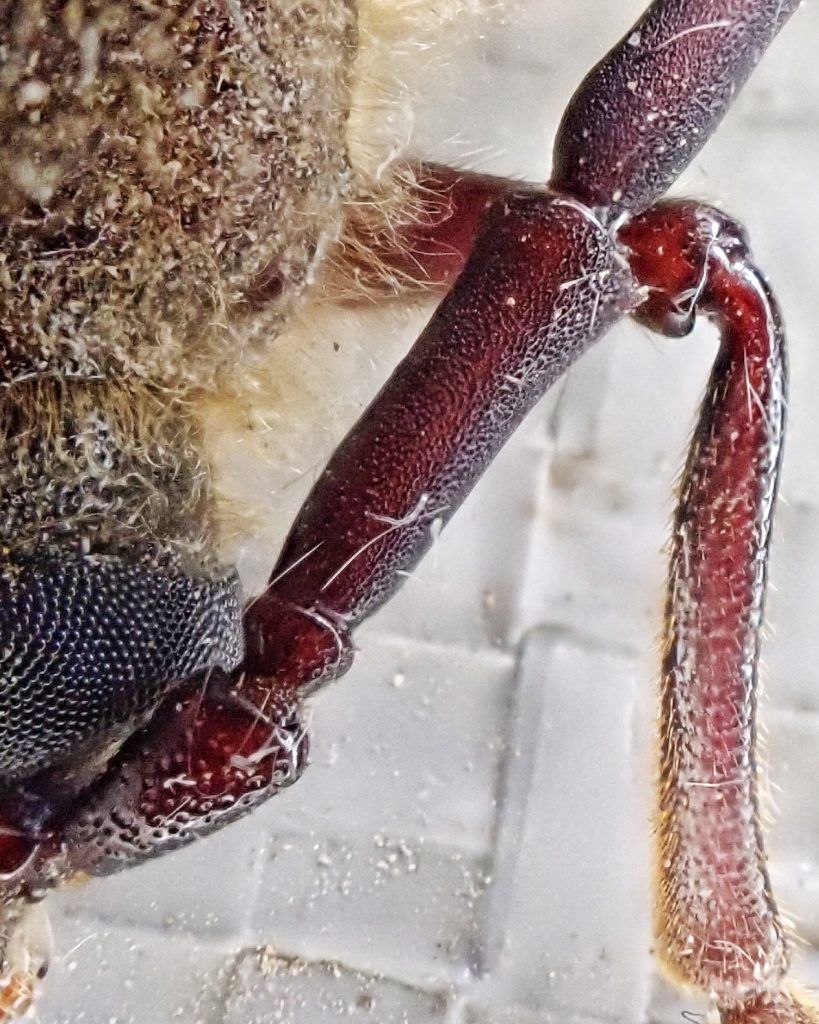
So, this was a very cool bit of serendipity. As I described in the blog Mt. Adams, I went mothing up near Mt. Adams on last Thursday night, and around midnight I found one of these large Tragosoma beetles. Having just written about T. harrisii I was aware that it could be T. soror, and more importantly I still remembered how to distinguish them. But I didn’t want to collect it if it was T. harrisii, since I prefer not to kill bugs needlessly. I tried to get some closeup photos of the diagnostic 3rd antennomere or the lateral pronotal spike, but they were inconclusive so I just left it hanging on the sheet.

But then, walking back to my primary Temple of Ultraviolet Light, it occurred to me that I had a hand lens in the van. So I grabbed it instead of checking the light, and went back to find that the big beetle was still there. And though I couldn’t really see the pronotal spike, I could clearly see the puncturing all of the way down the third antennomere, so I knew I had Tragosoma soror. I decided to collect it then, because I wanted to get a photo of the antennomere and pronotal spike under the microscope, and since it is a relatively newly described species, I figured my buddy Craig Sondergaard would like one for his extensive, future museum showpiece, insect collection. Although it did turn out that, when I found a second specimen, I was able to document the antennomere puncturing just by getting the right lighting angle, because it shows up in the photo as having a matte, rather than a shiny, appearance.

Description– Large (28-34mm) brown longhorn beetle with rusty brown hair covering the pronotum and most of the body; legs and antennae reddish brown, and antennae have cylindrical segments with a slight, but noticeable, lateral projection ; antennomere 3 with punctures on more than half; pronotal margin with a single, sharply tapering, narrow spike on each side.
Similar species– Tragosoma harrisii has antennomere 3 with punctures over less than half the length, and have lateral spike on pronotum wider and narrowing more gradually; Prionus have thicker, serrated antennae; Trichocnemis spiculatus is much larger and has a hairless pronotum.

Habitat– Coniferous forests.
Range– “This species ranges from southern British Columbia southeastward in the Rocky Mountains to central western Wyoming and southward along the Cascade range to the Sierra Nevada and the San Bernardino Mountains in central California.” Serge Laplante; 2017; “Description of a new Nearctic species of Tragosoma Audinet-Serville (Coleoptera: Cerambycidae: Prioninae), with species validations, new synonymies and a lectotype designation”

Eats– Probably Douglas-fir and various species of pines, but larval host records are unclear because most sightings of this species were labeled as Tragosoma depsarium, T. harrisii, or possibly T. spiculum.
Eaten by– Presumably a host for parasitoids in Hymenoptera and Diptera, and probably preyed upon by insectivores of all classes, but I can find nothing specific for this species.

Adults active– Nocturnal; June into September, with a peak in July-August
Life cycle– “Tragosoma larvae tunnel into the wood of decaying logs and stumps where they feed on sapwood and subsequently pupate (Linsley 1962, Laplante 2017). Tragosoma depsarium requires a period of at least three years to complete its life cycle (Cherapanov 1979).” Lyons-Yerion/Cook, et.al; 2022;

Etymology of names– Tragosoma appears to be from the Greek words for ‘goat body’, possibly because of the spikes on the pronotum, but I cannot verify what Audinet-Serville was actually referring to. The specific epithet soror is from the Latin word for ‘sister’, and denotes the presumed close relationship between this species and Tragosoma spiculum.

Species Tragosoma soror – BugGuide.Net

1 thought on “Tragosoma soror”